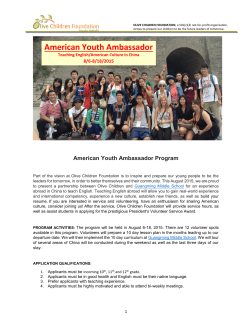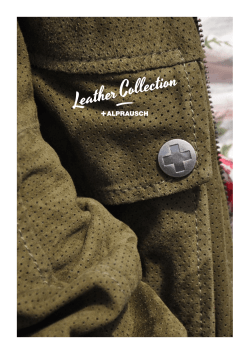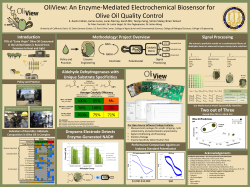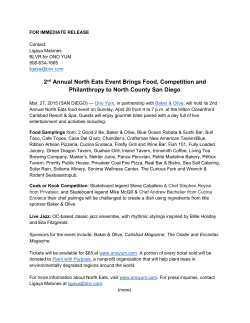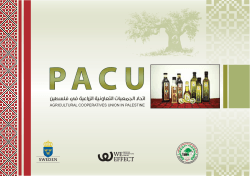
Waste of olives FAIR-CT98-9584
GENERIC SCIENCE AND ADVANCED TECHNOLOGIES FOR NUTRITIOUS FOODS FAIR: CO-OPERATIVE RESEARCH FOR SMEs A lot of trees each producing many olives generates a lot of waste (Courtesy: T. Morris) Waste of olives FAIR-CT98-9584 Olive production across the Mediterranean wastewater from the three-phase process. This Basin has a long and prestigious past, which wastewater needs treatment before disposal. today is firmly rooted in the economic, social Olive oil waste has always been one of the and cultural life of its inhabitants. Around the biggest problems associated with the industry. region, around eight million hectares are The environmental devastation, caused by the extraction technology has not brought new dedicated to olive cultivation producing, all accidental release of non-treated waste that waste disposal schemes but rather makes told, some 1,800,000 tons of oil. periodically occurs, bears witness to this. old techniques redundant. Consequently, The project concentrated on olive oil However, recent innovations in extraction production processes in Spain, Italy and Greece. To extract olive oil, three different methods are commonly used. The traditional been troubled with what to do with their waste. To make matters worse, new this project is coming up with a means of technology have resulted in new types of waste, recycling olive waste and putting it to new making much of existing waste treatment and recovery obsolete. press method is a non-continuous process which provides high purity extra virgin olive For a long time the olive oil industry has Not wasted at all uses. They will evaluate its potential agricultural, energetic, nutritional and pharmaceutical purposes. For the olive oil oils. The other two techniques are the two- and Nonetheless, this project – consisting of 19 three-phase decanter centrifuge methods. The partners from the UK, Spain, Italy, Greece and three-phase is a continuous process that The Netherlands – aims to develop uses for requires the addition of warm water to improve olive oil waste in five different areas. Using extraction, as is the two-phase which differs by carbon dioxide for supercritical fluid extraction operating without adding any water. This last is and the chemical compound 1,1,2- the most innovative technique and produces a tetrafluoroethane for solvent extraction, high semi-solid cake of pressed olive fruits and value-added components will be extracted. Both stones as opposed to the highly polluting processes are at the vanguard of extraction QUALITY OF LIFE AND MANAGEMENT OF LIVING RESOURCES industry, there need not be waste – only assets. GENERIC SCIENCE AND ADVANCED TECHNOLOGIES FOR NUTRITIOUS FOODS FAIR: CO-OPERATIVE RESEARCH FOR SMEs technology and will provide the raw materials Yet another part of the work package will try to for nutritional and pharmaceutical applications, break down waste through the use of anaerobic and flavours and oils. bacteria, leaving it in a less polluting form. While petrochemical oils are used for domestic Through this, methane could be produced which Recycling and use of waste from olive oil and commercial energy, there is no reason not could be used as an energy source. production to use other more natural oils for the same In agriculture, waste is often spread on the purpose. Hence the use of olive oil waste as a surface as a fertilizer, returning nutrients to the Robert Edyvean low cost renewable energy source will also be soil. Olive oil waste will be investigated to see Bethan Technology Ltd. targeted. This involves the absorption of spilt if it can be put to the same use to improve crop 175 Woodhouse Lane oil, which could then be incinerated for energy yield and quality. recovery. It has already been shown that the Through work conducted so far, the exact absorption of oil spills is feasible. chemical and physical properties of olive oil Biosorption is the process of biologically waste has been ascertained. This forms the recovering pollutants. Olive oil waste will be basis for much of this project’s future work. tested as an adsorbent of contaminants such In today’s climate of re-use and recycling it is as metals and colours from aqueous effluents. refreshing to see an industry that generates a Preliminary studies have shown that the waste lot of waste being able to put its waste to good adsorbs (i.e. binds) toxic cadmium, copper and use: a case of changing the age-old saying from lead – a promising early result. waste not, want not, to waste it, want it. INFORMATION FULL TITLE: CONTACT: Leeds LS2 3AR United Kingdom Tel.: +44-114-2227506 Fax: +44-114-2227501 E-mail: r.edyvean@sheffield.ac.uk PARTNERS: Tool & Steel Products Ltd (UK) B.E.K. Travaux Industriels-Constructions S.A. (GR) Coopérative Agricole de Mégara (GR) Eredi di Todisco Onofrio di Todisco Vito Antonio & C (IT) Barnaba Domenico (IT) Distribuciones de Novedades Tecnicas SL (ES) LOCATION Nuestro Padre Jesus S.C.A. (ES) Coopérative Agricole de Papadianika (GR) Coopérative Agricole de Crédit de Pelasgia (GR) GREECE ITALY University of Sheffield (UK) National Technical University of Athens (GR) Isituto Sperimentale Agronomico (IT) SPAIN THE NETHERLANDS UNITED KINGDOM Ingenieursburo Innogas BV (NL) EKO ELDA Société Anonyme industrielle et commerciale (GR) PROGRAMME: FAIR, Cooperative Research Measures JULY 2000
© Copyright 2025
